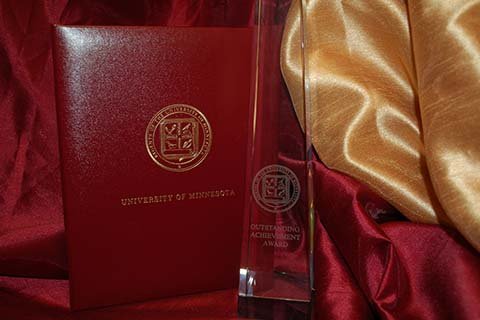Four CSE alumni receive Outstanding Achievement Awards

Honorees receive U’s highest alumni accolade
MINNEAPOLIS / ST. PAUL (9/15/2016)—The University of Minnesota Board of Regents recently honored four College of Science and Engineering alumni with the Outstanding Achievement Award (OAA) for 2016. The award is given to University of Minnesota graduates, or former students of the University, who have attained unusual distinction in their chosen fields or professions or in public service, and who have demonstrated outstanding achievement and leadership on a community, state, national, or international level.
The alumni receiving awards are:
John Bowers (Physics '76)
Professor, Department of Materials and Electrical and Computer Engineering
University of California-Santa Barbara
Considered an expert in the fields of electronic devices, device physics, and materials, Bowers is honored for his accomplishments in optoelectronics, including monolithic integration and coupling design for very different semiconductor materials. In his groundbreaking research, he has made important strides in integrating photonics with silicon semiconductor technology in order to add substantial new functionality to today’s computer chips. He has also devoted substantial effort to the field of energy research and is working on thermoelectricity, which provides a means for generation of electricity directly from waste heat. In work that will improve lives, he also leads a program to produce and donate solar-powered light-emitting-diode reading lamps for several underdeveloped countries around the world.
Gary Brudvig (Chem ’76)
Chair, Department of Chemistry
Yale University
A pioneering researcher, Brudvig is recognized for his contributions to our understanding of the oxygen-forming events in plants and in artificial photosynthetic systems, his extensive service contributions to the scientific community, and to the New Haven Teachers Institute. With solar energy conversion as the focus of his research, Brudvig has made highly significant contributions to understanding the molecular details of photosynthesis and the development of new oxygen-evolving catalysts. His research has appeared in 300 publications. As a tireless advocate of fostering science education, Brudvig is a regular presenter at the New Haven Teachers Institute, and has developed new teaching units on topics such as “Chemistry of Photosynthesis,” “Renewable Energy,” “Green Chemistry,” “Energy Sciences,” and “The Chemistry of Everyday Things.”
Bruce KenKnight (ME '84, BME M.S. '91, Ph.D. '97)
Vice President, Emerging Therapy for Heart Failure
LivaNova
KenKnight, a noted biomedical technologies innovator, is honored for his pioneering devices and therapies. KenKnight has accumulated nearly 150 patents and 50 peer-reviewed publications related to innovative medical devices and therapies for cardiac rhythm management and heart failure mitigation since his first industrial position with GE Medical in 1985. His work on fibrillation and defibrillation contributed to the fundamental understanding of the topic and played a significant role in expanding Boston Scientific's product line. He has held leadership positions at Guidant, Boston Scientific-CRM, Valtech Cardio, and currently LivaNova. Beyond his professional achievements, KenKnight has provided extensive service to the University of Minnesota as a dedicated educator and advisor in biomedical engineering. He is also an ardent supporter of FIRST Robotics.
Bradley Peterson (Physics '74)
Professor Emeritus, Department of Astronomy
Ohio State University
Peterson, a well-recognized leader in research, departmental stewardship, and NASA community service, is honored for developing and using the technique of "reverberation mapping" to determine the structure of the inner regions of quasars and their supermassive black holes. Quasars are the most luminous objects in the universe and can outshine entire galaxies like our Milky Way, with its 100 billion stars. Peterson has demonstrated important leadership throughout his career at Ohio State as well as in the U.S. astronomical community. During the decade Peterson served as leader, the Ohio State Astronomy Department grew to be one of the most prestigious of the 14 universities in the Big 10. At the national level, he made significant contributions to the astrophysics community by taking on many leadership roles particularly at NASA, the Space Telescope Science Institute, and the Goddard Space Flight Center.
